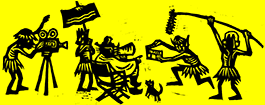|
| |
 |
|
|
| |
 |
鳳甲美術館 Hong-Gah Museum
|
台北市11268北投區大業路166號11樓(近捷運淡水線奇岩站)
開放時間 Open Hours 10:30-17:30(週一休館 Closed on Monday)
11F., No. 166, Daye Road, Beitou District, Taipei City 11268, Taiwan
TEL 886-2-28942272︱www.hong-gah.org.tw
|
|
| |
| |
|
 |
|
| |
鬼魂的迴返
展覽簡介
文──龔卓軍、高森信男 |
2014年台灣國際錄像藝術展「鬼魂的迴返」,可視為對過去三屆展覽的延續。透過了「居無定所?」、「食托邦」以及「憂鬱的進步」,台灣國際錄像藝術展累積了針對現代生存問題以及現代性發展的討論厚度。本屆「鬼魂的迴返」則是嘗試探尋現代性空間之外的敘事可能,並藉此回望由現代性敘述、全球化以及新自由主義所構成的現代世界。面臨全球化的現代史,在現代化的進程中,吸納了西方科學語言以及理性辯證式的邏輯,將之轉化為形塑世界的工具;在這種知識結構中,諸如泛靈論、超自然經驗、巫覡祭儀以及神鬼之說等思想及實踐,皆會被輕易的斥責為迷信或偽科學而加以排除。鬼魂的徘徊學,即是發展非現代影像敘事的一種努力。
近年來,「泛靈論」在歐美藝壇成為了熱門話題;一方面是為了理解被西方現代社會所長期掩蔽的文化結構、二方面是借之來理解現代消費文化中的拜物教傾向。然而「泛靈論」在台灣或非西方社會中,雖然被學院或知識階級所排除,卻是常民生活中的開放性景觀。也因此,在台灣重談泛靈及神鬼之說,自有其脈絡上的殊異性必須加以梳理;對於台灣創作者而言,鬼神世界並非遮蔽、隱晦的歷史謎團,而是具有普遍身體經驗的生活文化空間。面對這個特殊性,台灣及亞洲的創作者,往往將鬼魂的幽靈式主體,視作處理歷史檔案、以及政治現實的敘事方法。
本屆展覽包括邀請及徵件藝術家在內,共計30多位國內外的藝術家(團隊)參與,規模為歷屆之最;除此之外,本次展出意欲架設出時間軸線以及影像機具上的跨度:展出作品從1955年,讓.胡許的民族誌紀錄片《癲狂仙師》、80年代菲律賓導演奇拉.塔西米克創作的實驗電影《土倫巴》、90年代台灣導演黃明川創作的獨立電影《寶島大夢》,一直到當代國際新銳創作者的錄像及多媒體藝術創作。播放動態影像的平台則包括了十六厘米電影膠捲播映機器、映像管電視、數位投影器、一直到兼具互動功能的「i-pad」。播映空間除了美術館外,亦有在廟埕廣場、樂生、新店接待室、宜蘭等俗民空間與原拍攝場景的流動式投映,暗示了播映技術可能佔有的歷史敘述空間。「鬼魂的迴返」所欲描述的,不僅是對於西方現代性敘事的背離;同時也是迴返到影像美學的層次,透過時間、場所、機具、語言以及議題等召喚術,嘗試邀請觀眾親臨理解影像的魅影性質,體驗降鸞於其中的現代史鬼魂。 |
|
Introduction of Taiwan Internation Video Art Exhibition 2014 -
“The Return of Ghosts”
by GONG Jow-Jiun, TAKAMORI Nobuo |
The 4th Taiwan International Video Art Exhibition 2014 (2014 TIVA) – "The Return of Ghosts" can be seen as the sequel of the 3 previous exhibitions. With the curation of "Dwelling Place", "Eattopia", as well as "Melancholy in Progress", Taiwan International Video Art Exhibition has accumulated the depth and width for discourses on contemporary living agenda and the development of modernity. This year, "The Return of Ghosts" attempts to explore the narrative possibility beyond modernity space, so as to review the modern world constructed by modern narratives, globalization, and Neoliberalism. Modern history in the era of globalization absorbs the scientific language and the rational dialectic logic from the West in the process of modernization, becoming a tool that shapes the world. With such knowledge structure, the theories and practices such as animism, supernaturalism, witchcraft, spirits and ghosts are easily belittled as myths or pseudo-science and therefore are excluded as outcasts. The study of the return of ghosts is a de facto endeavor to develop non-modern video narratives.
In recent years, "Animism" has become a hit in the art society of the West as an instrument to comprehend the cultural structure shrouded by western modern society and to probe into the fetishism in contemporary consumer culture. Nonetheless, "Animism" in Taiwan and other non-western societies, though excluded by college and intelligentsia, is an open landscape in the life of commoners. Thus, the discourse on animism and spirits in Taiwan has its own contextual distinction which needs to be sorted out. For Taiwanese artists, spiritual world is not some shrouded, veiled history enigma, but a living cultural space filled with common, bodily experience. In the face of such distinction, the artists from Taiwan and Asia region tends to treat spiritual entities such as ghosts as a kind of narrative approach toward historical document as well as political reality.
"2014 TIVA" has more than 30 invited and selected artists (artistic group) participating in the event. The largest scale in this series exhibition. Furthermore, this exhibition aims to construct spans of timeline as well as of the device of moving images. The works exhibited include Jean Rouch’s Ethnographic film "Les Maîtres fous" (1955), Philippine director in the 80s, Kidlat Tahimik's experimental film "Turumba" (1983), Taiwanese director in the 90s, HUANG Ming-Chuan's independent film "Bodo" (1993), and the moving images and multimedia artworks of contemporary young artists from all corners of the world. The platforms that screen the moving images include 16mm film projectors, CRT TV sets, digital projectors, and i-Pads with interacting function. The screening space, in addition to the Museum itself, includes a square in front of a temple, Lo-Sheng Sanatorium and Hospital, Ankang Detention Center in XinDian, common space in YiLan, and the mobile theatre at the shooting site, suggesting the possible historical narrative space which screening technology may occupy. "The Return of Ghosts" tries not only to depict the departure from the western narrative of modernity, but also to return to the level of image aesthetics. Summoning via the power of time, space, device, language, and issues, we hereby invite audience to come to appreciate the phantom nature of images and to witness the ghosts of modern history possessing within. |
|
|
| 策展人──龔卓軍 |
策展人──高森信男 |
| 1966年,龔卓軍出生於台灣嘉義,並在1998年以《身體想像的辯證:尼采.胡塞爾.梅洛龐蒂》一文,獲得國立台灣大學哲學博士學位。隨後曾任教於淡江大學通識中心、中山大學哲學研究所。2006年,發表《身體部署:梅洛龐蒂與現象學之後》一書,獲台灣中央研究院年輕學者研究著作獎。2007年起,任教於國立台南藝術大學藝術創作理論研究所。2009年起,擔任《藝術觀點ACT》季刊主編。龔卓軍曾翻譯法國哲學家加斯東.巴舍拉的《空間詩學》、以及莫里斯.梅洛龐蒂的《眼與心》。近年來,龔卓軍開始進行當代藝術界的策展工作,曾於2013年於台北誠品畫廊策畫「Are We Working Too Much?」展覽、2014年6月於台南策畫「絕對不純粹」東亞論壇:報民/AABB─台南/東京交流計畫、10月於台南RICVA+r:ead #3「東亞對話駐村計畫#3」、11月於台北鳳甲美術館「鬼魂的迴返」台灣國際錄像藝術展。 |
高森信男(b. 1985),獨立策展人、交通大學應用藝術所博士候選人及北藝大講師,目前生活和工作於台北;擅長亞洲地區之跨文化與現代及當代藝術觀察,所策之展覽多涉及少數族裔、跨領域、歷史記憶、地方性等議題。2010年創立並主持「奧賽德工廠」策展團隊,曾策畫之展覽包括「後態度」,並在2011年於墨西哥的Ex Teresa Arte Actual展出;2012年的「南國.國南」台越藝術家交流計畫,則同時在越南胡志明市與台灣台南做展出;2013年夏天於GlogauAir德國柏林展出「Sommerreise」展覽、同年底則於台灣台南文化創意產業園區展出「藝術家博覽會主題展─府城風景」;2014年夏天的「拾荒花園」於誠品畫廊展出,同年11月「台灣國際錄像藝術展─鬼魂的迴返」則於台北鳳甲美術館展出。 |
|
|
GONG Jow-Jiun
|
TAKAMORI Nobuo |
Born 1966 in Chayi, Taiwan. In 1998, GONG graduated from the Department of Philosophy of the National Taiwan University with his dissertation "Dialectics between Body and Imagination: Nietzsche, Husserl, Merleau Ponty". After teaching positions at several universities in Taiwan, in 2007, he was appointed associate professor and director of the doctoral program in art creation and theory at the Tainan University of the Arts. From 2009, he also organized the quarterly art magazine Art Critique of Taiwan (ACT), as chief editor and chairman and established it as a public journal. One year later, in 2010, ACT won the Prize of National Publication as Outstanding Cultural Magazine. GONG is also acclaimed as Chinese translator of writings by Gaston Bachelard, Maurice Merleau-Ponty and Carl Gustav Jung into Chinese. Besides his research, GONG is engaging with curatorial activities. In 2013, he curated the exhibition "Are We Working too Much?" at the Eslite Gallery, Taipei. In 2014, he curated the Asian art forum, "Absolutely Impure East-Asia Forum: POST News/Art Against Black Box—Tainan/Tokyo Exchange Project", Tainan; "residency east-asia dialogue (r:ead) #3", Tainan; and "The 4th Taiwan International Video Art Exhibition 2014 - The Return of Ghosts", Hong-Gah Museum, Taipei. |
Nobuo TAKAMORI, born in 1985, an independent curator, a lecturer in Taipei National University of the Arts, and a Ph.D. candidate in the Institute of Applied Arts, National Chiao Tung University, currently lives and works in Taipei. TAKAMORI excels at the observations on the cross-culture and contemporary arts in Asia. The exhibitions he curated were mostly involving issues on local, ethnic minorities, interdisciplinary, historical memory, etc. He established in 2010 and runs a curation group "Outsiders Factory", curating numerous exhibitions including "Post - Actitud" (Ex Teresa Arte Actual, Mexico City, Mexico, 2011), a Vietnamese & Taiwanese Artists Exchange Project "South Country, South of Country" (Ho Chi Minh City, Vietnam; Tainan, Taiwan, 2012), "Sommerreise" (GlogauAir, Berlin, Germany; Main Exhibition "Urbanscape in Tainan", Artist Fair Taiwan, Tainan Cultural & Creative Industries Park, 2013), "The Lost Garden" (Eslite Gallery, Taipei, Taiwan, 2014), and "The 4th Taiwan International Video Art Exhibition 2014 - The Return of Ghosts" (Hong-Gah Museum, Taipei, 2014). |
|
|
|



